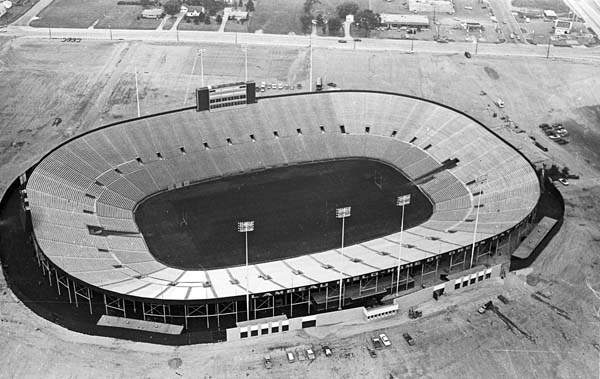When ESPN opens its Saturday coverage of the college football season on Sept. 3, the locale for College GameDay will be a most unlikely one: Lambeau Field, home of the Green Bay Packers, which will be hosting its first college game since 1983.
There is not a rich tradition of college football at Lambeau Field, which opened in 1957 as home of the Packers. Indeed, exactly three college games have been played at Lambeau Field. Nearby St. Norbert College hosted three games there over the years, all wins for the Green Knights: Mankato State in 1960 and Fordham in 1982 and 1983. This year sees the launch of the Lambeau Field College Classic, featuring the University of Wisconsin and LSU in the season-opening kickoff.
For Lambeau Field, it’s an addition to the history of one of the most unique and historic NFL stadiums. When Lambeau Field opened in 1957, the NFL was not as focused on facilities as it would be in later years: NFL teams played in ballparks (Forbes Field, Wrigley Field, Yankee Stadium, Tiger Stadium), older and larger civic stadiums (Kezar Stadium, Los Angeles Coliseum), and the first multiuse facilities (Baltimore’s Memorial Stadium).
There really was no notion of a football-only stadium on the professional level. Indeed, in the mid-1950s, the NFL was still a scruffy outlier in the football world; this was the end of the great era of nationwide college football, when fans crammed into huge on-campus stadiums to see their Buckeyes and Gophers and Bulldogs in action. Those huge stadiums sat empty on Sundays, when the pros set up shop in ballparks and public stadiums.
Indeed, the notion of a pro football stadium was an odd one in 1957 – especially when you consider the team’s previous home was a high-school field, City Stadium, next to East High School. True, it was not an ordinary high-school field, seating 25,000. The Packers would dress in the high-school locker room, and the visiting team usually dressed in their hotel before busing over to the stadium. That stadium is still used for high-school football, by the way, but not in the same state as when the Packers played there between 1925 and 1956: all the seating has been removed, but the front gate in 2007 was designed and restored to invoke memories of the Packers era. (The address is 1500 E Walnut St., right off the corner of Walnut and Baird, if you want to make a pilgrimage.)
But City Stadium had deteriorating wooden bleachers, and it was clear to the Packers and city leaders that a new stadium was needed. After voters approved a referendum in 1956 allowing for construction of a new stadium, the city and the Packers split the $960,000 cost of the new stadium built on farmland on the outskirts of Green Bay. The next City Stadium opened on Sept. 29, 1957, with chief rival Chicago Bears in town. Vice President Richard Nixon and NFL Commissioner Bert Bell saw the Packers triumph, 21-17, in a game that served as the highlight of a forgettable 3-9 season. It was the only home game won by the Packers. And despite the financial commitment to the new stadium, the Packers split home game with Milwaukee, a practice that started in the Great Depression. The Packers lost all three games at Milwaukee County Stadium and lost the other two games at City Stadium.
In 1965 the stadium was renamed Lambeau Field in honor of Curly Lambeau, whose hard work kept the team afloat during some very trying times. Lambeau did pretty much everything—he began as a founder on the team, wore the Packers uniform as a player and then served as coach and GM before he passed away in the summer of 1965. (A statue of Lambeau greets visitors to Lambeau Field.)
That was in the first period of glory for Lambeau Field, when Vince Lombardi put together one of the greatest set of teams ever in the NFL, where Bart Starr, Ray Nitschke and Forrest Gregg ruled the gridiron. It didn’t hurt that the 1960s became the time that professional football burst onto the national imagination thanks to the incredible growth of television, and the Packers were the dominant team of the era, winning NFL championships in 1961, 1962, 1965, 1966 and 1967, including in the first two Super Bowls. Much of the team’s mystique came from its dominance in the 1960s, and the home-field advantage at Lambeau Field was a large part of that mystique.
Indeed, it would be until 1971 until the next NFL-only stadium would open, when the newly christened New England Patriots debuted in Shaefer Stadium; the Kansas City Chiefs would open the next NFL-only stadium, Arrowhead Stadium, in 1972. Today, most teams play in NFL-only stadiums: the Raiders, Eagles and Los Angeles Rams share stadiums with other teams (the Oakland A’s, Temple and USC Trojans, respectively), but new stadiums could reduce that number to zero in the next three years. When that happen, the rest of the league will catch up to a trend started in 1957 by the Green Bay Packers.
ESPN College GameDay is set to run from 8 a.m. to 11 a.m. CST. Tailgating begins at 10:30 a.m., with gametime set for 2:30 p.m.



